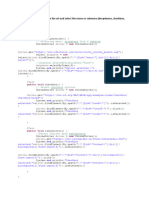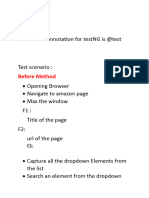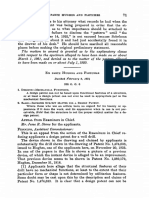Jaas in Action - Chapter06 02
Jaas in Action - Chapter06 02
Uploaded by
Supritha PandithCopyright:
Available Formats
Jaas in Action - Chapter06 02
Jaas in Action - Chapter06 02
Uploaded by
Supritha PandithOriginal Title
Copyright
Available Formats
Share this document
Did you find this document useful?
Is this content inappropriate?
Copyright:
Available Formats
Jaas in Action - Chapter06 02
Jaas in Action - Chapter06 02
Uploaded by
Supritha PandithCopyright:
Available Formats
JAAS in Action by Coté / www.JAASbook.com/ www.DrunkAndRetired.
com
6 A Custom Policy
This chapter describes an example of implementing a custom java.security.Policy . The
Policy we’ll develop is actually composed of several parts: a CompositePolicy that
delegates to any number of “sub-Policy” implementations; a database-backed Policy that
retrieves permission grants from a database; and the default file-based Policy. Aggregating a
Policy like this allows for more flexibility and code reuse. As with previous chapters, we’ll
use a small class with a main() method to demonstrate using the custom Policy .
Our custom Policy takes one large short cut to simplify the example: Permission
checks are effectively only applied when a Subject is logged in, allowing most code to
execute with all permissions enabled. With that disclaimer aside, let’s jump into the code.
6.1 The “Main” Application
The simple application we use initializes the custom Policy and SecurityManager, creates
a test user, and then does a simple Permission check for reading a temporary file. The first
check will fail because the required java.ioFilePermission hasn’t been added to any of
the Subject ’s Principals. Before doing a second check, the application associates the
needed FilePermission to one of the Subject ’s Principals. After the
FilePermission has been added, the call to SecurityManager.checkPermission()
returns successfully.
Below is the code used to run the example:
package chp06;
import java.io.FilePermission;
import java.security.Policy;
import java.security.PrivilegedAction;
import java.util.ArrayList;
import java.util.List;
import javax.security.auth.Subject;
import util.id.Id;
public class Main {
static public void main(String[] args) throws Exception {
This work is licensed under a Creative Commons Attribution-NonCommercial 2.5
License: http://creativecommons.org/licenses/by-nc/2.5/
JAAS in Action by Coté / www.JAASbook.com/ www.DrunkAndRetired.com
AuthHelper authHelper = new AuthHelper();
try {
Policy defaultPolicy = Policy.getPolicy();
DbPolicy dbPolicy = new DbPolicy();
List policies = new ArrayList(2);
policies.add(defaultPolicy);
policies.add(dbPolicy);
CompositePolicy p = new CompositePolicy(policies);
Policy.setPolicy(p);
System.setSecurityManager(new SecurityManager());
authHelper.createTestUser("testuser", "testpassword");
authHelper.loginTestUser();
Subject subject = authHelper.getSubject();
final FilePermission filePerm = new FilePermission(
"/tmp/test", "read");
boolean allowed = true;
try {
Subject.doAsPrivileged(subject, new PrivilegedAction() {
public Object run() {
SecurityManager sm = System.getSecurityManager();
if (sm != null) {
sm.checkPermission(filePerm);
}
return null;
}
}, null);
} catch (SecurityException e) {
allowed = false;
}
if (allowed) {
System.out.println("Subject can read file /tmp/test");
} else {
System.out.println("Subject cannot read file /tmp/test");
}
Id principalId = authHelper.getUserGrp().getId();
PermissionService.addPermission(principalId, Id.create(),
This work is licensed under a Creative Commons Attribution-NonCommercial 2.5
License: http://creativecommons.org/licenses/by-nc/2.5/
JAAS in Action by Coté / www.JAASbook.com/ www.DrunkAndRetired.com
filePerm);
System.out.println("Added " + filePerm + " to Subject.");
allowed = true;
try {
Subject.doAsPrivileged(subject, new PrivilegedAction() {
public Object run() {
SecurityManager sm = System.getSecurityManager();
if (sm != null) {
sm.checkPermission(filePerm);
}
return null;
}
}, null);
} catch (SecurityException e) {
allowed = false;
}
if (allowed) {
System.out.println("Subject can read file /tmp/test");
} else {
System.out.println("Subject cannot read file /tmp/test");
}
} finally {
if (authHelper != null) {
authHelper.cleanUp();
}
}
}
To run the above, change directories to the root of this book’s project and execute the
command ant run-chp06 . The output will include:
Subject cannot read file /tmp/test
Added (java.io.FilePermission /tmp/test read) to Subject.
Subject can read file /tmp/test
6.1.1 Initializing the Custom Policy
As its name suggests, the CompositePolicy is an implementation of the Composite
pattern: a CompositePolicy delegates it’s behavior to the 0-to-n Policys it holds, and
This work is licensed under a Creative Commons Attribution-NonCommercial 2.5
License: http://creativecommons.org/licenses/by-nc/2.5/
JAAS in Action by Coté / www.JAASbook.com/ www.DrunkAndRetired.com
instances of CompositePolicy can be used wherever a java.security.Policy can be
used.
The CompositePolicy instance we use is composed of two Policys: the default J2SE
Policy1, obtained by calling the static method Policy.getPolicy() and our custom
chp06.DbPolicy . The default Policy performs Permission assignments and checks for
legacy code, and also assigns several basic permissions to every security context. For
example, the default Policy grants the permission to access many simple, low-risk properties.
Rather than re-implement this behavior, we just re-use the default Policy in our
CompositePolicy . The DbPolicy , discussed below in section 6.3, is backed by a database,
and provides us with a more dynamic runtime way of doing authorization checks.
Once the CompositePolicy and its sub-Policies are created, the application enables the
authorization by calling two static set methods: one method to set our CompositePolicy as
the VM-wide Policy, Policy.setPolicy(), and another method to enable the default
java.lang.SecurityManager , System.setSecurityManager() .
The CompositePolicy is covered in more detail below, section 6.2.
6.1.2 Creating and Authenticating the Test User
The helper class chp06.AuthHelper is used to create, authenticate, and then cleanup the
Subject and its Principals that are used in the example. As the focus of this chapter is
authorization, the code isn’t excerpted here.
6.1.3 Checking Permissions
To check if the Subject has been authorized to read the file /tmp/test , the code first creates
a java.io.FilePermission instance describing the target and action, creates a security
context based on the Subject ’s authorizations, and then uses the
SecurityManager.checkPermission() . If the FilePermission has been granted,
checkPermission() silently succeeds, otherwise it throws a SecurityException .
The Subject.doAsPrivileged() is used to limit the security context to only the
Permissions granted to the Subject ’s Principals. As discussed in section 5.7 of the
previous chapter, the alternative is to use the Subject.doAs() method, which instead
combines the Subject ’s Principals with the each ProtectionDomain in the execution
stack, namely the ProtectionDomain that represents chp06.Main .
6.2 The CompositePolicy
The purpose of CompostePolicy is to allow any number of Policys to be in effect at one
time. As with any Policy implementation, the CompositePolicy implements the three
methods: getPermissions(CodeSource), getPermissions(ProtectionDomain) , and
the implies(ProtectionDomain, Permission). The first two methods combine the
Permissions of returned by the aggregated into one java.security.Permissions object,
1
Implemented by the class sun.security.providers.PolicyFile, and, by default,
backed by the file <JAVA_HOME/>lib/security/java.policy.
This work is licensed under a Creative Commons Attribution-NonCommercial 2.5
License: http://creativecommons.org/licenses/by-nc/2.5/
JAAS in Action by Coté / www.JAASbook.com/ www.DrunkAndRetired.com
which is returned. The implies() method returns if at least one of the aggregated Policys
returns true from their implies() method; that is, for a Permission to be granted to a
ProtectionDomain , at least one of it’s aggregate Policys must return true from it’s
implies() method.
The code for CompositePolicy is below:
package chp06;
import java.security.CodeSource;
import java.security.Permission;
import java.security.PermissionCollection;
import java.security.Permissions;
import java.security.Policy;
import java.security.ProtectionDomain;
import java.util.ArrayList;
import java.util.Collections;
import java.util.Enumeration;
import java.util.Iterator;
import java.util.List;
import java.util.logging.Level;
import java.util.logging.Logger;
public class CompositePolicy
extends Policy {
private List policies = Collections.EMPTY_LIST;
public CompositePolicy(List policies) {
this.policies = new ArrayList(policies);
}
public PermissionCollection getPermissions(ProtectionDomain domain) {
Permissions perms = new Permissions();
for (Iterator itr = policies.iterator(); itr.hasNext();) {
Policy p = (Policy) itr.next();
PermissionCollection permCol = p.getPermissions(domain);
for (Enumeration en = permCol.elements(); en
.hasMoreElements();) {
Permission p1 = (Permission) en.nextElement();
perms.add(p1);
}
}
return perms;
}
public boolean implies(final ProtectionDomain domain,
final Permission permission) {
for (Iterator itr = policies.iterator(); itr.hasNext();) {
Policy p = (Policy) itr.next();
if (p.implies(domain, permission)) {
return true;
This work is licensed under a Creative Commons Attribution-NonCommercial 2.5
License: http://creativecommons.org/licenses/by-nc/2.5/
JAAS in Action by Coté / www.JAASbook.com/ www.DrunkAndRetired.com
}
}
return false;
}
public PermissionCollection getPermissions(CodeSource codesource) {
Permissions perms = new Permissions();
for (Iterator itr = policies.iterator(); itr.hasNext();) {
Policy p = (Policy) itr.next();
PermissionCollection permsCol = p.getPermissions(codesource);
for (Enumeration en = permsCol.elements(); en
.hasMoreElements();) {
Permission p1 = (Permission) en.nextElement();
perms.add(p1);
}
}
return perms;
}
public void refresh() {
for (Iterator itr = policies.iterator(); itr.hasNext();) {
Policy p = (Policy) itr.next();
p.refresh();
}
}
}
6.3 DbPolicy
The chp06.DbPolicy relies on the UserGroupPrincipal class introduced in chapter 4,
although it supports a wide variety of Permission implementations, including it’s own
DbPermission. DbPolicy implements the three Policy methods,
getPermissions(CodeSource) , getPermissions(ProtectionDomain) , and
implies(ProtectionDomain, Permission). As mentioned in the overview, DbPolicy
takes a shortcut by only providing authorization services for Subjects: if the security
context does not include a Subject , the DbPolicy grants all permissions. Though this helps
illustrate the inter-workings of JAAS, it can be extremely dangerous depending on your
security requirements.
First, we’ll look at the code. The rest of this section will then go over different methods
in DbPolicy .
package chp06;
import java.security.AccessController;
import java.security.AllPermission;
import java.security.CodeSource;
import java.security.Permission;
This work is licensed under a Creative Commons Attribution-NonCommercial 2.5
License: http://creativecommons.org/licenses/by-nc/2.5/
JAAS in Action by Coté / www.JAASbook.com/ www.DrunkAndRetired.com
import java.security.PermissionCollection;
import java.security.Permissions;
import java.security.Policy;
import java.security.Principal;
import java.security.PrivilegedActionException;
import java.security.PrivilegedExceptionAction;
import java.security.ProtectionDomain;
import java.sql.SQLException;
import java.util.Arrays;
import java.util.Enumeration;
import java.util.HashSet;
import java.util.Iterator;
import java.util.List;
import java.util.Set;
import java.util.logging.Level;
import java.util.logging.Logger;
import chp04.UserGroupPrincipal;
public class DbPolicy
extends Policy {
public PermissionCollection getPermissions(CodeSource codesource) {
// others may add to this, so use heterogeneous Permissions
Permissions perms = new Permissions();
perms.add(new AllPermission());
return perms;
}
public PermissionCollection getPermissions(
final ProtectionDomain domain) {
final Permissions permissions = new Permissions();
// Look up permissions
final Set principalIds = new HashSet();
Principal[] principals = domain.getPrincipals();
if (principals != null && principals.length > 0) {
for (int i = 0; i < principals.length; i++) {
Principal p = principals[i];
if (p instanceof UserGroupPrincipal) {
UserGroupPrincipal userGroup = (UserGroupPrincipal) p;
principalIds.add(userGroup.getId());
}
}
if (!principalIds.isEmpty()) {
try {
List perms = (List) AccessController
.doPrivileged(new PrivilegedExceptionAction() {
public Object run() throws SQLException {
return PermissionService
.findPermissions(principalIds);
This work is licensed under a Creative Commons Attribution-NonCommercial 2.5
License: http://creativecommons.org/licenses/by-nc/2.5/
JAAS in Action by Coté / www.JAASbook.com/ www.DrunkAndRetired.com
}
});
for (Iterator itr = perms.iterator(); itr.hasNext();) {
Permission perm = (Permission) itr.next();
permissions.add(perm);
}
} catch (PrivilegedActionException e) {
// Log
}
}
} else if (domain.getCodeSource() != null) {
PermissionCollection codeSrcPerms = getPermissions(domain
.getCodeSource());
for (Enumeration en = codeSrcPerms.elements(); en
.hasMoreElements();) {
Permission p = (Permission) en.nextElement();
permissions.add(p);
}
}
return permissions;
}
public boolean implies(final ProtectionDomain domain,
final Permission permission) {
if (permission.getName().equals("/tmp/test.tx")) {
int i = 0;
}
PermissionCollection perms = getPermissions(domain);
boolean implies = perms.implies(permission);
return implies;
}
public void refresh() {
// does nothing for DB.
}
}
6.3.1 getPermissions(ProtectionDomain)
Most of the behavior of DbPolicy is done by getPermssions(ProtectionDomain) . The
other getPermissions(CodeSource) method, as noted above, grants all permissions to
any CodeSource , while the implies method simply uses the PermissionCollection
returned by getPermissions(ProtectionDomain) to perform authorization.
getPermissions(ProtectionDomain) first checks if a Subject is logged in, by
getting the Principals associated with the passed in ProtectionDomain . If there are no
This work is licensed under a Creative Commons Attribution-NonCommercial 2.5
License: http://creativecommons.org/licenses/by-nc/2.5/
JAAS in Action by Coté / www.JAASbook.com/ www.DrunkAndRetired.com
2
Principals, we assume that there is no Subject logged in . In such cases,
getPermissions(ProtectionDomain) delegates to getPermissions(CodeSource) ,
which grants all permissions.
If a Subject with Principals is logged in, getPermissions(ProtectionDomain)
first gathers all of the Subject ’s DbUserGroupPrincipal Id ’s, and then uses
PermissionService to retrieve the associated Permissions. The union of all the
Permissions is returned in a java.security.Permissions instance, which allows us to
collect different types of Permissions together.
Privileged Code
Also, notice that the call to PermissionService.findPermissions() is done in a
privileged code block. The database code used by PermissionService.findPermission()
requires that certain java.io.SocketPermissions be granted to the current security
context. The only Permission we’ve granted to the Subject , however, is the ability to
read the temporary file /tmp/test . The Subject does not have the required
SocketPermissions to connect to the database.
To get around this, enabling the DbPolicy to access the database regardless of which
Subject is logged in two conditions must be satisfied:
1. The ProtectionDomain that represents chp06.DbPolicy must be granted the
appropriate SocketPermissions .
2. A Privileged code block must be created to execute the sensitive database code in.
This Privileged block will exclude the Subject ’s Principals and, thus,
Permission restrictions, from the security context.
Because of the shortcut we’ve taken, any code that executes without a Subject is granted
java.security.AllPermission , granting all Permissions, including the
SocketPermissions we need. So, by creating a Privileged code block around the call the
PermissionService.findPermission() , we exclude considering the Subject in the
authorization checks, thus, allowing the needed SocketPermission . See section 5.5.2 in
chapter 5 for more discussion on using privileged blocks.
6.3.2 UserGroupPrincipals Only
The DbPolicy works only with UserGroupPrincipals to support the database schema it
relies on. In the database, each Principal is assigned a unique Id. The Principal interface
doesn’t guarantee that the Principal ’s name will be unique in any context, so a different
field must be used for a unique identifier, provided by UserGroupPrincpal ’s Id field.
Limiting the Principals that a Policy supports in this way would be too constrictive if
the DbPolicy were the only Policy that could be used at one time. But, since we provide a
CompositePolicy , other Policys that do not have this limitation can co-exist, allowing
other types of Principals to be used and supported by other Policys. For example, the use
2
This does leave a loophole in which a Subject with no Principals is granted all
Permissions.
This work is licensed under a Creative Commons Attribution-NonCommercial 2.5
License: http://creativecommons.org/licenses/by-nc/2.5/
JAAS in Action by Coté / www.JAASbook.com/ www.DrunkAndRetired.com
of the SDK’s default Policy allows our application to support Principals other than
DbUserGroupPrincipal , albeit through the standard flat-file.
6.3.3 The Database and PermissionService
The PermissionService provides the data access layer between the DbPolicy and the
database. As with the DbLoginModule , pure JDBC calls are used to simplify the example.
Using JDBC directly like this isn’t required, of course. In production systems, it may be
appropriate for you to use more featureful data-access libraries like Hibernate, Spring, or
EJBs.
PermissionService provides methods for adding Permissions to Principals,
looking up the Permissions granted to Principals, and for removing Permissions and
their association to Principals.
Database Schema
Each of PermissionService ’s static methods relies, of course, on the permission schema
in the database. The schema includes the tables from chapter XXX [authentication chapter],
and the tables below:
CREATE TABLE permission
(
id varchar(64) NOT NULL,
permissionClass varchar(255) NOT NULL,
name varchar(64),
actions varchar(255),
PRIMARY KEY (id )
);
CREATE TABLE principal_permission
(
principal_id varchar(64) NOT NULL,
permission_id varchar(64) NOT NULL
);
The permission table is responsible for storing each Permission assigned to a Principal .
Each entry must have an Id and a fully qualified class name. The name and actions columns
are optional. The principal_permission table is a tie table used to associate
Permissions to Principals.
PermissionService Implementation
The code for PermissionService is listed below. Most of the code is simple JDBC code
that does the grunt work of creating, reading, and updating the Permissions stored in the
database. The primary point of interest are the attempts to reflectively create the loaded
Permissions, marked by code annotations.
This work is licensed under a Creative Commons Attribution-NonCommercial 2.5
License: http://creativecommons.org/licenses/by-nc/2.5/
JAAS in Action by Coté / www.JAASbook.com/ www.DrunkAndRetired.com
package chp06;
import java.lang.reflect.Constructor;
import java.lang.reflect.InvocationTargetException;
import java.security.Permission;
import java.security.Principal;
import java.security.UnresolvedPermission;
import java.security.cert.Certificate;
import java.sql.Connection;
import java.sql.PreparedStatement;
import java.sql.ResultSet;
import java.sql.SQLException;
import java.util.ArrayList;
import java.util.Collections;
import java.util.Iterator;
import java.util.List;
import java.util.Set;
import java.util.logging.Level;
import java.util.logging.Logger;
import util.db.DbService;
import util.id.Id;
public class PermissionServiceNoLogging {
static private final Certificate[] EMPTY_CERTS = new Certificate[0];
static private final Class[] ZERO_ARGS = {};
static private final Object[] ZERO_OBJS = {};
static private final Class[] ONE_STRING_ARG = { String.class };
static private final Class[] TWO_STRING_ARGS = { String.class,
String.class };
static public void removePermission(Id id) throws SQLException {
removePermissions(Collections.singleton(id));
}
static public void removePermissions(Set ids) throws SQLException {
Connection conn = null;
try {
conn = DbService.getInstance().getConnection();
String sql = "DELETE FROM principal_permission WHERE
permission_id = ?";
PreparedStatement tiePstmt = conn.prepareStatement(sql);
PreparedStatement permPstmt = conn
.prepareStatement("DELETE FROM permission WHERE id= ?");
for (Iterator itr = ids.iterator(); itr.hasNext();) {
// HSQLDB doesn't support addBatch() :(
Id id = (Id) itr.next();
This work is licensed under a Creative Commons Attribution-NonCommercial 2.5
License: http://creativecommons.org/licenses/by-nc/2.5/
JAAS in Action by Coté / www.JAASbook.com/ www.DrunkAndRetired.com
tiePstmt.setString(1, id.getId());
permPstmt.setString(1, id.getId());
tiePstmt.executeUpdate();
permPstmt.executeUpdate();
}
} finally {
if (conn != null) {
conn.close();
}
}
static public List findPermissions(Set principalIds)
throws SQLException {
// HSQLDB doesn't allow batching, so we have to do a call per id
List permissions = new ArrayList();
for (Iterator itr = principalIds.iterator(); itr.hasNext();) {
Id principalId = (Id) itr.next();
permissions.addAll(findPermissions(principalId));
}
return permissions;
}
static public List findPermissions(Id principalId)
throws SQLException {
List perms = new ArrayList();
Connection conn = null;
try {
conn = DbService.getInstance().getConnection();
String sql = "SELECT permission.id id, "
+ "permission.permissionClass clazz, permission.name name, "
+ "permission.actions actions "
+ "FROM principal_permission, permission "
+ "WHERE principal_permission.principal_id=? "
+ "AND permission.id=principal_permission.permission_id ";
PreparedStatement pstmt = conn.prepareStatement(sql);
pstmt.setString(1, principalId.getId());
ResultSet rs = pstmt.executeQuery();
while (rs.next()) {
String idStr = rs.getString("id");
Id id = Id.create(idStr);
String clazzStr = rs.getString("clazz");
String name = rs.getString("name");
String actions = rs.getString("actions");
Permission perm = null;
// make class
Class clazz = null;
perm = createPermission(id, clazzStr, name, actions);
This work is licensed under a Creative Commons Attribution-NonCommercial 2.5
License: http://creativecommons.org/licenses/by-nc/2.5/
JAAS in Action by Coté / www.JAASbook.com/ www.DrunkAndRetired.com
if (perm != null) {
perms.add(perm);
} else {
continue;
}
}
} finally {
if (conn != null) {
conn.close();
}
}
return perms;
}
private static Permission createPermission(Id id,
String clazzStr, String name, String actions) {
Permission perm = null;
Class clazz = null;
try {
clazz = Class.forName(clazzStr);
} catch (ClassNotFoundException e) {
// deal with below
}
if (clazz == null) {
perm = new UnresolvedPermission(clazzStr, name, actions,
EMPTY_CERTS);
} else if (clazz.equals(DbPermission.class)) {
perm = new DbPermission(id, name, actions);
} else if (Permission.class.isAssignableFrom(clazz)) {
try {
if (name == null && actions == null) {
Constructor con = clazz.getConstructor(ZERO_ARGS); #1
perm = (Permission) con.newInstance(ZERO_OBJS);
} else if (actions == null) {
Constructor con = clazz.getConstructor(ONE_STRING_ARG); #1
perm = (Permission) con
.newInstance(new String[] { name });
}
// BasicPermission types
else if (name != null && actions != null) {
Constructor con = clazz.getConstructor(TWO_STRING_ARGS); #1
perm = (Permission) con.newInstance(new String[] { name,
actions });
}
} catch (Exception e) {
// Log
}
}
return perm;
This work is licensed under a Creative Commons Attribution-NonCommercial 2.5
License: http://creativecommons.org/licenses/by-nc/2.5/
JAAS in Action by Coté / www.JAASbook.com/ www.DrunkAndRetired.com
static public void addPermission(Id principalId,
DbPermission dbPermission) throws SQLException {
addPermission(principalId, dbPermission.getId(), dbPermission);
}
static public void addPermission(Id principalId, Id permissionId,
Permission permission) throws SQLException {
Connection conn = null;
try {
conn = DbService.getInstance().getConnection();
PreparedStatement pstmt = conn
.prepareStatement("INSERT INTO permission VALUES (?, ?, ?,
?)");
pstmt.setString(1, permissionId.getId());
pstmt.setString(2, permission.getClass().getName());
pstmt.setString(3, permission.getName());
pstmt.setString(4, permission.getActions());
pstmt.executeUpdate();
PreparedStatement pstmt2 = conn
.prepareStatement("INSERT INTO principal_permission VALUES
(?, ?)");
pstmt2.setString(1, principalId.getId());
pstmt2.setString(2, permissionId.getId());
pstmt2.executeUpdate();
} finally {
if (conn != null) {
conn.close();
}
}
}
(annotation) <#1 the findPermissions() method uses reflection extensively to create the Permission
instances retrieved from the database. Because Permission instances are not required to have a default, no argument
constructors, each instance must be reflectively created by attempting to acquire the
java.lang.reflect.Constructor needed, as dictated by the presence of absence of the name and
actions attributes. If an appropriate Constructor cannot be found, or and er ro r occurs using it, the Permission
is skipped, avoiding the “throwing out the baby with the bathwater” effect where one bad apple ruins the whole bar rel.
For a much more detailed discussion of reflection, see the Forman’s Java Reflection in Action.>
Summary
This chapter demonstrated integrating JAAS authorization functionality with a database. To
accomplish this goal, first we created a CompositePolicy class that allowed us to use
multiple Policys at the same time. Next, we created a custom Policy implementation that
was backed by a database rather than a flat file. Using a database instead of the flat files allows
This work is licensed under a Creative Commons Attribution-NonCommercial 2.5
License: http://creativecommons.org/licenses/by-nc/2.5/
JAAS in Action by Coté / www.JAASbook.com/ www.DrunkAndRetired.com
your application to more easily specify Permissions at runtime and provides an easier way
to maintain all of the Permission grants in your system than flat files.
This work is licensed under a Creative Commons Attribution-NonCommercial 2.5
License: http://creativecommons.org/licenses/by-nc/2.5/
You might also like
- The Effects of Work Immersion Program To The Employability of The Graduating Students of Pagsulhugon National High SchoolDocument10 pagesThe Effects of Work Immersion Program To The Employability of The Graduating Students of Pagsulhugon National High SchoolMaria Theresa Deluna Macairan75% (4)
- Jaas in Action - Chapter02 05Document14 pagesJaas in Action - Chapter02 05Supritha PandithNo ratings yet
- Module 3 - AssignmentDocument11 pagesModule 3 - AssignmentpriyankaNo ratings yet
- PowerFlex PowerAPIDocument11 pagesPowerFlex PowerAPIramshankarNo ratings yet
- AttackingDocument56 pagesAttackingDouglas DiasNo ratings yet
- Java StudyDocument61 pagesJava StudykrushnakanNo ratings yet
- @@TestNG 3Document38 pages@@TestNG 3vizcareer11No ratings yet
- STQA Data Provider and Annotations Assignment 6Document13 pagesSTQA Data Provider and Annotations Assignment 6171-2022 Pranav MhalsekarNo ratings yet
- Selenium - TestNgDocument14 pagesSelenium - TestNgJASPER WESSLYNo ratings yet
- Practical No 8 (C)Document3 pagesPractical No 8 (C)jenni kokoNo ratings yet
- Selenium Cheat Sheet 1700837961Document6 pagesSelenium Cheat Sheet 1700837961vardhmansinghbhatiNo ratings yet
- Code CA3Document6 pagesCode CA3suvratshukla809No ratings yet
- ClouduploadDocument51 pagesClouduploadDimuth KurukulasooriyaNo ratings yet
- AnnotationsDocument21 pagesAnnotationsybkumaryeddanapudiNo ratings yet
- Login EstDocument14 pagesLogin EstHanumanth SeleniumTrainingsNo ratings yet
- REST Assured Automation Resource 1Document28 pagesREST Assured Automation Resource 1sahanaNo ratings yet
- MEIT 6 FinalDocument10 pagesMEIT 6 FinalVijay S. GachandeNo ratings yet
- 3 JUnitDocument71 pages3 JUnitSrinivasa HelavarNo ratings yet
- CódigoDocument48 pagesCódigoDomingos Filipe OliveiraNo ratings yet
- Workshop 6Document34 pagesWorkshop 6SurendraNo ratings yet
- SolutionDocument20 pagesSolutionSmreeta ShresthaNo ratings yet
- Annexe TP Spring Security: Step 1Document15 pagesAnnexe TP Spring Security: Step 1abdeouahedfananNo ratings yet
- Hibernate Table Per Hierarchy Using AnnotationDocument5 pagesHibernate Table Per Hierarchy Using AnnotationAkanksha BhagiaNo ratings yet
- Selenium Real Time Scenarios PDFDocument41 pagesSelenium Real Time Scenarios PDFAnand DhanaNo ratings yet
- Selenium Interview QuestionsDocument14 pagesSelenium Interview Questionspooja ChaudhariNo ratings yet
- Kunal Java Unit-2Document11 pagesKunal Java Unit-2manglamdubey2011No ratings yet
- S Det Selenium Imp FileDocument77 pagesS Det Selenium Imp Filemanikumarmalle132No ratings yet
- Unit 2 Java ProgrammingDocument10 pagesUnit 2 Java ProgrammingRahul VermaNo ratings yet
- Spring 4+JMS+ActiveMQ Example With @JmsListener & @EnableJms - WebSystiqueDocument17 pagesSpring 4+JMS+ActiveMQ Example With @JmsListener & @EnableJms - WebSystiqueVibhor BhardwajNo ratings yet
- Security CookbookDocument12 pagesSecurity CookbookFerao SlpsNo ratings yet
- Security SDK Update StepsDocument3 pagesSecurity SDK Update Stepsravikirang731No ratings yet
- DataDriven (Advance Selenium)Document4 pagesDataDriven (Advance Selenium)Apoorva v HejjajiNo ratings yet
- Problem FileDocument6 pagesProblem FileAnkit DusadNo ratings yet
- 47079473Document5 pages47079473Azeem TalibNo ratings yet
- Entre VistaDocument5 pagesEntre VistaLuis PadillaNo ratings yet
- MST 2Document14 pagesMST 2gurly101No ratings yet
- Operating System: (Fall/ Spring 20 - )Document74 pagesOperating System: (Fall/ Spring 20 - )Azeem TalibNo ratings yet
- MC LAB Exno 9Document8 pagesMC LAB Exno 9vanithaNo ratings yet
- Methods and Loops Notes (Genie Ashwani)Document6 pagesMethods and Loops Notes (Genie Ashwani)Vishal singhNo ratings yet
- Class Securitymanager: Direct Known SubclassesDocument25 pagesClass Securitymanager: Direct Known SubclassespcdproyectoNo ratings yet
- Hibernate BasicsDocument48 pagesHibernate BasicsJeremias Barrios HermosaNo ratings yet
- Hibernate - Practical - 1 (XML Based)Document6 pagesHibernate - Practical - 1 (XML Based)Manoj RameshNo ratings yet
- Extent Listener ClassDocument5 pagesExtent Listener Classabhishek dabralNo ratings yet
- PHP MYSQL-Android StudioDocument23 pagesPHP MYSQL-Android Studiomyhddex ternNo ratings yet
- Junit Tutorial - Testing Framework For Java: Types of Unit TestingDocument14 pagesJunit Tutorial - Testing Framework For Java: Types of Unit Testingrina mahure0% (1)
- Uploading Downloading PDF Files in ASP - NET MVC Using SQL ServerDocument4 pagesUploading Downloading PDF Files in ASP - NET MVC Using SQL ServerhsuyipNo ratings yet
- Struts + Hibernate Integration ExampleDocument3 pagesStruts + Hibernate Integration ExampleDeepakNo ratings yet
- Drools Example JBPM 5Document5 pagesDrools Example JBPM 5Yesid Raad RomeroNo ratings yet
- MockitoDocument12 pagesMockitovaram10No ratings yet
- Creating A Properties File in EclipseDocument6 pagesCreating A Properties File in EclipseKavithaNo ratings yet
- Creating A Properties File in EclipseDocument6 pagesCreating A Properties File in EclipseKavithaNo ratings yet
- Extending Struts - Torry Harris WhitepaperDocument4 pagesExtending Struts - Torry Harris WhitepaperTorry Harris Business SolutionsNo ratings yet
- Source CodeDocument3 pagesSource CodeSouravNo ratings yet
- 6 CodeIgniter Hacks For The MastersDocument17 pages6 CodeIgniter Hacks For The Masterssinyo2104No ratings yet
- DidiSoft OpenPGP Library For Java Version 2.5Document28 pagesDidiSoft OpenPGP Library For Java Version 2.5hazapataNo ratings yet
- TestNG With SeleniumDocument10 pagesTestNG With SeleniumJASPER WESSLYNo ratings yet
- Spring Hibernate JSF Primefaces IntergrationDocument21 pagesSpring Hibernate JSF Primefaces IntergrationHuy Quan VuNo ratings yet
- User and Data Security: Lesson 1: Authenticating and Authorising UsersDocument22 pagesUser and Data Security: Lesson 1: Authenticating and Authorising UsersnurainhazwaniNo ratings yet
- GC Reddy TestNGDocument13 pagesGC Reddy TestNGKavithaNo ratings yet
- Spring Boot整合Spring SecurityDocument5 pagesSpring Boot整合Spring SecurityChiNo ratings yet
- Proposed Pud "Planned Unit Development" in IloiloDocument7 pagesProposed Pud "Planned Unit Development" in IloiloShanthy Chua GarciaNo ratings yet
- Enr 20171127-1204Document116 pagesEnr 20171127-1204vtNo ratings yet
- L&TDocument16 pagesL&Ttasneem subhanNo ratings yet
- Problems Faced by Small Scale Fishing Community in OdishaDocument10 pagesProblems Faced by Small Scale Fishing Community in OdishaAnonymous CwJeBCAXpNo ratings yet
- Ex Parte Hughes and Fletcher: Decided February 9, 1924Document3 pagesEx Parte Hughes and Fletcher: Decided February 9, 1924Sarah BursteinNo ratings yet
- The SSMC Wellhead System Is - CedipDocument8 pagesThe SSMC Wellhead System Is - CedipAaron Vazquez Martinez100% (1)
- Antipolo City HistoryDocument9 pagesAntipolo City HistorySien CruzNo ratings yet
- Ic Brochure 2015 17 - 41366 PDFDocument56 pagesIc Brochure 2015 17 - 41366 PDFSaurabh KumarNo ratings yet
- Dead LockDocument23 pagesDead Lockjohn onesmoNo ratings yet
- Srs Event Management System PDF FreeDocument4 pagesSrs Event Management System PDF FreeShubham YadavNo ratings yet
- TestDocument18 pagesTestDeepa SureshNo ratings yet
- 4 CIR Exam Fee Arrear Regular StudentsDocument1 page4 CIR Exam Fee Arrear Regular Studentskanishkaprakash25043No ratings yet
- AerodynamicsDocument221 pagesAerodynamicskyoobumNo ratings yet
- PWP Practical PDFDocument13 pagesPWP Practical PDFPiyush SahaneNo ratings yet
- Chapter-1 Homework Basic Concepts Part 1Document4 pagesChapter-1 Homework Basic Concepts Part 1Kenneth Christian WilburNo ratings yet
- 5.3 Social Impacts of The Industrial RevolutionDocument36 pages5.3 Social Impacts of The Industrial RevolutionMissDang100% (2)
- Criminal OrganizationsDocument5 pagesCriminal OrganizationsVíctor GonzálezNo ratings yet
- Consultant RTU Weekly Site Report Week 1Document3 pagesConsultant RTU Weekly Site Report Week 1tayyab zafarNo ratings yet
- Project CharterDocument28 pagesProject CharterAli SyedNo ratings yet
- Leak GisDocument14 pagesLeak GisTravis WoodNo ratings yet
- Module 2: Types of Information SystemsDocument80 pagesModule 2: Types of Information SystemsGeorge OkemwaNo ratings yet
- 19 C New PO 56235256201449 DT 01-SEP-23 On VINDHYA TELELINKS LIMITED-REWADocument8 pages19 C New PO 56235256201449 DT 01-SEP-23 On VINDHYA TELELINKS LIMITED-REWAManojNo ratings yet
- Gramatica Limbii Engleze TimpurileDocument37 pagesGramatica Limbii Engleze TimpurilebastajelenaNo ratings yet
- Mozilla Public License 2.0Document15 pagesMozilla Public License 2.0Sydney D. BajentingNo ratings yet
- Miller Axel ANSYS 2013 DetroitDocument26 pagesMiller Axel ANSYS 2013 DetroitSrashmiNo ratings yet
- Blendi 3 Recruitment of EmployeesDocument7 pagesBlendi 3 Recruitment of EmployeesMark Leo RosendoNo ratings yet
- Bca Unit Iii Mgt. AcoountingDocument13 pagesBca Unit Iii Mgt. AcoountingGautham SajuNo ratings yet
- OpenText Capture Center Product Sheet PDFDocument5 pagesOpenText Capture Center Product Sheet PDFMihai PaunescuNo ratings yet
- Send WhatsApp and Email Without VBADocument6 pagesSend WhatsApp and Email Without VBALuis Alberto GNo ratings yet

























































































